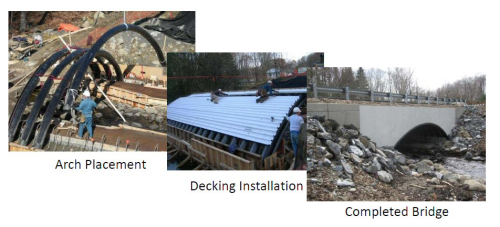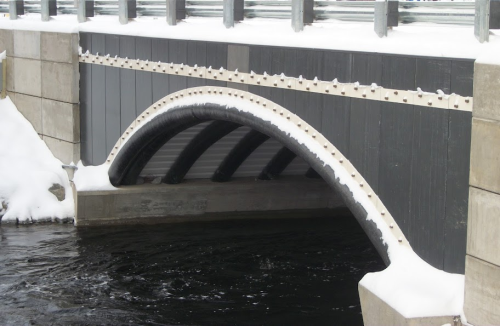

Staying the course
An award-winning advocate for FRP materials in construction applications is Dr. Habib Dagher, Director of the Advanced Structures and Composites Centre at the University of Maine (UMaine), Orono, Maine, USA.
He is also a founding board member of Orono-based Advanced Infrastructure Technologies, or AIT Bridges, a company that has commercialised his invention of Bridge-in-A-Backpack. This bridge building concept utilises glass and carbon fibre/ vinyl ester arches as easy-to-install, stay-in-place concrete forms for bridge superstructure components and headwall systems. The name comes from the fact that the braided composite form for the arches could be rolled up and carried to a construction site in the type of consumer backpack used for carrying hockey equipment.
Dagher’s entire career serves as an example of what can come out of innovative thinking translated to original R&D, and ultimately spawning new products that enhance the use of FRP in construction. With a design team at AIT, Dagher won the ASCE Charles Pankow Award in 2011 for this technology. In 2010, the technology garnered ACMA’s Most Creative Composite Product Award and Dagher, with contractor, Kleinfelders/SEA Consultants, won the American Council of Engineering Companies (ACEC) Engineering Excellence Award. AIT Bridges’ commercial system represents the fruition of a decade of Dagher’s research with his engineering students and colleagues at the University of Maine.
Well before this particular innovation, he conducted testing and development at UMaine of other construction enhancements with FRP, wood plastic composites (WPCs), and FRP/concrete hybrid materials. These include testing another 2010 ACMA award winner, the hybrid composite beam. Additional recent patents assigned to Dagher and UMaine colleagues encompass glass-reinforced wood panels for wall, roof and floor strengthening, and a novel manufacturing process for wood/polypropylene panels reinforced with FRP sheets that are double belt pressed. This agglomeration of the composite increases manufacturing productivity and decreases thermal stresses that can occur with secondary bonding processes.
After 20 years’ experience at UMaine examining composites in construction (and most recently in deepwater offshore wind technology), and working in strategic partnerships with construction contractors, Dagher remains optimistic about the cost competitiveness of FRP construction products and the marketplace advantage of hybridising FRP with conventional construction materials.
Reinforced Plastics: What’s the unique material hybridisation in the Bridge-in-a-Backpack concept, and how does this affect total cost of a bridge installation?
Dagher: The arches themselves are made in a braided, flexible form from glass and carbon fibres with a vinyl ester matrix, and are inflated and filled with concrete. In bridge construction, the composite arch provides superior tensile properties because FRP is much stronger in tension than unreinforced concrete – at about a 15-to-1 ratio. Concrete, of course, is well proven in compression performance, so this innovation capitalises on the best performance properties of each material.
For total installed cost, we found that Bridge-in-a-Backpack can beat conventional concrete, primarily because the materials hybridisation is a winning recipe rather than some magic trick. In my view, however, there’s a much larger issue involved here than using composites and traditional materials in strategic combination to keep cost down and enhance each material. Our nation doesn’t have the money needed for adequate infrastructure replacement or rehabilitation, and the driving impetus today is to cut spending. When that happens, we cut innovation, and cutting innovation is dangerous relative to our position in global competition. Investments still need to be made, even in the face of deficits.
Echoing Busel’s experience, Dagher agrees that: “Standards adoption is key and critical, along with creating a durability database. The last thing anyone wants is an FRP bridge failure, so it’s no wonder the bridge industry is conservative and has been slower to adopt composites. They have reason to be in terms of public safety.”
| We have to be patient, and demonstrate successful projects on the ground with sufficient monitoring to develop databases of 10 to 20 years of in-field operation. |
| Dr Habib Dagher, Director, Advanced Structures and Composites Centre, University of Maine |
He believes further proliferation of FRP depends upon “showing the construction industry and engineers positive experiences with FRP structures. We have to be patient, and demonstrate successful projects on the ground with sufficient monitoring to develop databases of 10 to 20 years of in-field operation.”
Obviously Dagher can speak to the importance of giving new engineers the experience of composites in their academic training, and to cultivating innovative thinking that can travel into the marketplace. Still, he cautions “this reality is something of a chicken/egg dilemma. If there’s not sufficient demand for using composites, where will our graduates go to work, and what motivation do they have to study the FRP materials option? There is market pull in both education and business. We must recognise this, and stay the course.”
Hybrid carries the load
The need to “stay the course” in an industry still eyeing FRP with skepticism is certainly a daily reality for AIT Bridges, the UMaine spin-off company that began commercial applications of the Bridge-in-a-Backpack innovation in 2009. To date, the company has completed 10 bridge installations in Maine, New Hampshire and Massachusetts, including the initial pilot project for the technology in Pittsfield, built in 2008. Last year, the company installed the largest composite arch bridge in the world in Caribou, Maine.
In these installations, 0.30 m or 0.38 m (12 or 15 inch) diameter, braided carbon and glass fibre/vinyl ester tubes are vacuum-infused and then filled with concrete to form arches that provide stay-in-place concrete formwork and structural reinforcement. The completed installations encompass a range of three to 23 composite arches that meet bridge spans of 7. 3 m to 16.2 m (24 ft to 54 ft).
Barry Raeburn, Executive Vice President of Business and Corporate Development, Government Relations and Company Growth Management for AIT Bridges, reports that bridges built using this technology “are designed in accordance with the AASHTO LRFD Bridge Design Specifications, with the exception of the composite components. The concrete-filled FRP arch tubes are designed in accordance with the proposed AASHTO LRFD Guide Specification for Design of Concrete-Filled FRP Tubes for Flexural and Axial Members. AIT helped develop this specification, which has passed review by AASHTO’s FRP Technical Committee. The composite decking in the system is designed in accordance with the ASCE Prestandard for LRFD of Pultruded FRP Structures. Also, inspection recommendations are available from detailed research, such as the National Cooperative Highway Research Program 564 (2006), sponsored by AASHTO and the FHWA.”
Reinforced Plastics: What refinements has AIT brought to the Bridge-in-a-Backpack technology as a result of the experience of these 10 installations, and what does the company’s new project log book look like for this year?
Raeburn: Since our first installations, we have refined the design model to better account for soil/structure interaction. Early AIT designs didn’t factor in the load-bearing and safety benefits of this interaction that have been demonstrated in the actual installations. Our enhanced design capitalises on the soil/structure interaction and allows for wider arch spacing, double that of earlier installations. This reduces cost and installation time without sacrificing safety.
We have also refined our foundation analysis and headwall details, providing more design options, better constructability and additional cost savings. Tolerances and appearance of arch components have been significantly improved, along with specifications for the self-consolidating concrete mix, which adds to performance reliability.
In the US, AIT expects to build bridges in Michigan, Maine and most other New England states in 2012-2013. We should have our first bridge in the mid-Atlantic states during this same time period. Seven other states are in the planning stages with their first installations, including a few central and western states. Internationally, AIT has submitted proposals for bridges in five different countries, and we expect to build our first international structure in the Caribbean this spring.
Raeburn states that AIT Bridges has met with 22 of the 50 US state Departments of Transportation so far. The company is also working with the government in Russia to apply Bridge-in-a-Backpack technology to the country’s rail bridges, which standardise on 10 m (33 ft) span increments, and require resistance to the harsh Arctic environment.
“They need light weight materials, resistant to alkaline corrosion, high durability and low maintenance requirements,” Raeburn explains.
So far, actual arch installation time within completed bridge projects has ranged from half a day to four days. In Raeburn’s opinion: “Contractor motivation really determines this more than any requirements of our technology. When lead times are not critical, an average-sized bridge can be manufactured with one crew working one shift per day, enabling delivery in less than two calendar weeks. In emergency response cases, AIT can add shifts to complete engineering design, manufacture, and delivery of arch components in approximately 30-45 days.”
| Our system actually comprises only about 2% composites and 98% self-consolidating concrete. It’s the hybrid nature of the system that really carries the structural load and enables longer-lasting structures. |
| Barry Raeburn, AIT Bridges |
Cure of the composite arches, with wall thickness up to half an inch, is conducted at room temperature over about three hours, and can be accomplished on site. AIT Bridges has used marine grade vinyl ester from a number of suppliers, and the carbon/glass fibre reinforcement comes in braided form, Raeburn verifies.
He also points out that “our system actually comprises only about 2% composites and 98% self-consolidating concrete. It’s the hybrid nature of the system that really carries the structural load and enables longer-lasting structures.” Further, he says “the design of the arches within the headwall and superstructure of a bridge allows for many flexible design load characteristics and safety factors, over and above AASHTO requirements.”
Life cycle cost of the Bridge-in-a-Backpack technology is about half that of a traditional concrete bridge reinforced with steel rebar. Raeburn estimates that, for a skewed two-lane, 15-18 m (50-60 ft) long structure, we can save up to 20% in materials and reduce construction complexity.” [Skewed refers to bridge-to-ground placement at an angle.] ♦
This article is an excerpt from the feature Infrastructure innovations, which was published in the May/June 2012 issue of Reinforced Plastics magazine. Part 1 of this feature is available here. Part 3 is available here.



